Analytical identification of ergot alkaloids in Ipomoea species: Resolving historical, forensic, and legal ambiguities
IF 2.2
3区 医学
Q2 CHEMISTRY, ANALYTICAL
引用次数: 0
Abstract
This study addresses the longstanding taxonomic confusion between two plant species within the Convolvulaceae family: Ipomoea tricolor Cav. and Ipomoea violacea L., historically mistaken as synonymous. Employing advanced analytical methods including LC-MS/MS (Orbitrap), coupled with genetic barcoding, we provide clear biochemical differentiation between the two species based on the presence or absence of psychoactive ergoline alkaloids. Our analyses confirm that seeds of I. tricolor consistently contain significant levels of psychoactive compounds structurally similar to LSD, while I. violacea seeds lack these alkaloids entirely. This distinction is critical, as current legislative documents frequently misclassify non-psychoactive I. violacea as a controlled substance, inadvertently omitting the psychoactive I. tricolor. The analytical method is robust and precise, providing an effective forensic tool for the accurate identification of these botanically similar but chemically distinct species. Correct taxonomic and biochemical identification of these plants is essential to law enforcement and policy-makers for accurate legal scheduling and preventing regulatory misinterpretation regarding plant-derived psychoactive substances.

麦角生物碱的分析鉴定:解决历史、法医和法律上的歧义
本研究解决了旋花科两种植物之间长期存在的分类混淆:三色旋花。和紫牡丹,历史上被误认为是同义词。采用先进的分析方法,包括LC-MS/MS (Orbitrap),结合遗传条形码,我们基于是否存在精神活性麦角碱生物碱,提供了两个物种之间明确的生化区分。我们的分析证实,三色堇种子始终含有显著水平的与LSD结构相似的精神活性化合物,而紫堇种子完全缺乏这些生物碱。这种区别是至关重要的,因为目前的立法文件经常错误地将非精神活性堇菜归类为受控物质,无意中遗漏了精神活性三色堇菜。该分析方法可靠、准确,为准确鉴定这些植物相似但化学成分不同的物种提供了有效的法医工具。对这些植物进行正确的分类和生化鉴定,对于执法和政策制定者准确的法律安排和防止对植物源性精神活性物质的监管误解至关重要。
本文章由计算机程序翻译,如有差异,请以英文原文为准。
求助全文
约1分钟内获得全文
求助全文
来源期刊

Forensic Chemistry
CHEMISTRY, ANALYTICAL-
CiteScore
5.70
自引率
14.80%
发文量
65
审稿时长
46 days
期刊介绍:
Forensic Chemistry publishes high quality manuscripts focusing on the theory, research and application of any chemical science to forensic analysis. The scope of the journal includes fundamental advancements that result in a better understanding of the evidentiary significance derived from the physical and chemical analysis of materials. The scope of Forensic Chemistry will also include the application and or development of any molecular and atomic spectrochemical technique, electrochemical techniques, sensors, surface characterization techniques, mass spectrometry, nuclear magnetic resonance, chemometrics and statistics, and separation sciences (e.g. chromatography) that provide insight into the forensic analysis of materials. Evidential topics of interest to the journal include, but are not limited to, fingerprint analysis, drug analysis, ignitable liquid residue analysis, explosives detection and analysis, the characterization and comparison of trace evidence (glass, fibers, paints and polymers, tapes, soils and other materials), ink and paper analysis, gunshot residue analysis, synthetic pathways for drugs, toxicology and the analysis and chemistry associated with the components of fingermarks. The journal is particularly interested in receiving manuscripts that report advances in the forensic interpretation of chemical evidence. Technology Readiness Level: When submitting an article to Forensic Chemistry, all authors will be asked to self-assign a Technology Readiness Level (TRL) to their article. The purpose of the TRL system is to help readers understand the level of maturity of an idea or method, to help track the evolution of readiness of a given technique or method, and to help filter published articles by the expected ease of implementation in an operation setting within a crime lab.
 求助内容:
求助内容: 应助结果提醒方式:
应助结果提醒方式:


